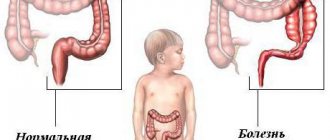The author of the article is Olga Petrovna Chuklina, general practitioner, therapist. Work experience since 2003.
Intestinal obstruction is a condition in which the passage of food through the intestines is disrupted. In this case, a complete or partial disruption of the movement of intestinal contents may occur.
The following groups are most at risk of developing intestinal obstruction:
- aged people;
- persons who have undergone surgery on the intestines and stomach.
Types and reasons
Intestinal obstruction is divided into the following types:
- dynamic,
- mechanical,
- vascular.
The type is determined by the cause that caused this pathological condition.
Causes of dynamic obstruction:
- constant spasm of the intestinal muscles, which can occur with painful irritation of the intestines by worms, with acute pancreatitis, with traumatic injuries from foreign bodies;
- paralysis of the intestinal muscles, which develops during surgical interventions, poisoning with morphine-containing drugs, salts of heavy metals, as a result of food infections.
In case of mechanical obstruction, there must be some kind of obstacle:
- fecal stones, stones from the biliary tract, foreign body, compression of the intestinal lumen from the outside by tumor formations and cystic formations of other organs, intestinal tumors growing into the lumen;
- volvulus of intestinal loops as a result of intestinal strangulation at the gates of abdominal hernias, adhesions and cicatricial processes, a knot of intestinal loops.
Vascular obstruction is always facilitated by disturbances in the blood supply (thrombosis, embolism) of the mesenteric blood vessels.
Symptoms of intestinal obstruction
Intestinal obstruction is an acute condition, that is, all the symptoms of the disease develop quickly, within a few hours.
There are several characteristic signs of the disease:
- pain in the abdomen;
- stool retention;
- vomit;
- violation of the passage of gases.
Intestinal obstruction always begins with the appearance of abdominal pain. The cramping nature of the pain is explained by the presence of peristaltic contractions of the intestine, which contribute to the movement of food masses.
In the presence of intestinal volvulus, the pain is immediately intense, unbearable, and constant. If there is another type of intestinal obstruction, the pain may be cramping and gradually increase in intensity. The patient appears in a forced position - he presses his legs to his stomach.
The pain can be so severe that the patient goes into pain shock.
Vomiting develops early if the patient has an obstruction in the upper intestine (small intestine), and the patient experiences it repeatedly, but does not bring relief.
With obstruction in the lower intestines, it appears only with the development of general intoxication of the body, after 12-24 hours.
Impaired passage of stool and gases is especially characteristic of lower intestinal obstruction. The patient experiences bloating and rumbling.
If assistance is not provided to the patient, after about a day the patient develops general intoxication of the body, which is characterized by:
- increased body temperature;
- increased respiratory movements;
- peritonitis (damage to the peritoneum);
- septic process (spread of infection throughout the body);
- disturbance of urination;
- severe dehydration.
As a result of general intoxication, if left untreated, the patient may die.
Types of intestinal obstruction in a newborn: criteria for classification
Many different pathological processes can cause intestinal obstruction in children.
There are congenital and acquired obstructions. Congenital intestinal obstruction is caused by a violation of the intrauterine development of the child.
Its reasons may be:
- embryonic intestinal malformations;
- disruption of the process of intestinal rotation during the formation of the gastrointestinal tract;
- pathology of development of other abdominal organs.
Acquired intestinal obstruction in children is a consequence of inflammatory processes or surgery.
There are several classifications of intestinal obstruction according to various criteria:
1) Presence or absence of a physical obstacle
Intestinal obstructions are divided into: mechanical and dynamic.
- Mechanical obstruction is a physical blockage of the intestine by a tumor, scar tissue, or other type of blockage that prevents intestinal contents from passing through the point of blockage;
- dynamic obstruction occurs when the healthy wave-like contractions of the muscles of the intestinal walls (peristalsis) that move digestive products through the gastrointestinal tract are disrupted or stop altogether.
2) Level of the affected intestinal area
These are high and low intestinal obstruction:
- high intestinal obstruction in newborns is observed with atresia (fusion) or stenosis (narrowing) of the duodenum;
- Low intestinal obstruction may result from atresia or stenosis of the small intestine, ileum, and ascending colon.
3) Degree of obstruction:
- complete intestinal obstruction. With it, there is an absolute absence of stool;
- With partial obstruction, a small amount of stool passes.
4) Rate of development of symptoms:
- acute intestinal obstruction in children is characterized by rapidly developing symptoms;
- chronic. It is characterized by slowly developing symptoms, pain may not appear. More common with high intestinal obstruction.
Symptoms of intestinal obstruction in acute form, unlike chronic ones, progress slowly, but tend to suddenly intensify or accelerate.
5) Number of points of obstruction:
- simple obstruction. This is when there is a disturbance in the movement of intestinal contents due to the presence of a physical obstruction blocking the lumen, but the contents of the lumen can move backwards;
- closed loop. This occurs when the intestinal lumen is blocked at two points where the intestinal contents are unable to move forward or backward;
- strangulated obstruction. Occurs when there is a disruption in the blood supply to the blocked segment.
Diagnostics
To make a diagnosis of intestinal obstruction, a number of laboratory and instrumental studies are required:
- general blood test - there may be an increase in leukocytes during inflammatory processes;
- a biochemical blood test may indicate metabolic disorders (impaired composition of microelements, decreased protein);
- An X-ray examination of the intestine is mandatory when making this diagnosis. By introducing a radiopaque substance into the intestinal lumen, the level of development of intestinal obstruction can be determined;
- colonoscopy (examination of the large intestine using a sensor with a video camera at the end) helps with colonic obstruction; irrigoscopy is used to examine the small intestine;
- Ultrasound examination is not always informative, since with intestinal obstruction, air accumulates in the abdomen, which interferes with the normal assessment of data;
In difficult cases, a laparoscopic examination of the abdominal cavity is performed, in which a sensor with a video camera is inserted into the abdominal cavity through a small puncture. This procedure allows you to examine the abdominal organs and make an accurate diagnosis, and in some cases immediately carry out treatment (volvulus, adhesions).
It is necessary to differentiate intestinal obstruction from:
- acute appendicitis (ultrasound, localized in the right iliac region);
- perforated ulcers of the stomach and duodenum (FGDS, radiography with a contrast agent);
- renal colic (ultrasound, urography).
To clarify the diagnosis, additional research methods are always necessary, since it is impossible to differentiate intestinal obstruction by symptoms alone.
Low intestinal obstruction
Low intestinal obstruction means all types of obstruction of the small and large intestine, with the exception of duodenal obstruction. The causes of intestinal obstruction may be intestinal atresia, membrane, cystic duplication of the intestine, lymphangioma of the mesentery of the small intestine, meconium ileus, Hirschsprung's disease.
The diagnosis of intestinal obstruction can be suspected during antenatal examination. Ultrasound of the fetus reveals dilated intestinal loops. When antenatally diagnosing intestinal obstruction, cystic fibrosis should be excluded. For this purpose, the blood of both future parents and the fetus is tested for the presence of the cystic fibrosis gene. If both parents are heterozygous for the cystic fibrosis gene, then the birth of an affected child is very likely, and in this case it is advisable to recommend termination of pregnancy. If there is no evidence of cystic fibrosis in a fetus with signs of intestinal obstruction and the parents are interested in having a child, the pregnancy can and should be maintained.
If intestinal obstruction was diagnosed antenatally, immediately after the birth of the child it is necessary to install a gastric tube and empty the stomach, and transfer the newborn to a specialized hospital.
A child with low intestinal obstruction has a bright clinical picture from the first day of life. There is bloating of the abdomen, there is no passage of meconium, and instead of it, light mucus leaves the rectum, the child experiences vomiting with an admixture of bile, and then stagnant contents. If these symptoms appear, it is necessary to immediately exclude enteral feeding, install a gastric tube and empty the stomach, and transfer the newborn to a specialized hospital.
The main method for diagnosing low intestinal obstruction is x-ray examination, which begins with plain radiographs in an upright position. With low intestinal obstruction, plain radiographs can reveal increased gas filling of intestinal loops, dilated loops, and sometimes the presence of levels.
To clarify the diagnosis, all children must undergo irrigography with water-soluble contrast in the first hours. An irrigogram for low intestinal obstruction allows for differential diagnosis between small intestinal atresia, meconium ileus and Hirschsprung's disease.
In case of Hirschsprung's disease, conservative treatment is possible at the first stage. When meconium ileus is detected, high hypertensive enemas with water-soluble contrast are performed, which allows intestinal obstruction to be resolved in most children.
Preoperative preparation for low intestinal obstruction is brief, no more than 3 hours. The blood type and Rh factor, biochemical blood parameters, acid-base status, general blood test are determined, and infusion and antibacterial therapy is carried out.
The scope of surgical treatment depends on the type of pathology and existing complications. If possible, a primary oblique intestinal anastomosis is formed according to the “end to end” type. If, due to the large difference in the diameter of the adducting and efferent sections of the intestine, it is not possible to form a primary anastomosis, then a T-shaped unloading anastomosis is created, or an enterostomy is performed.
In the postoperative period, as passage through the intestines is restored, enteral feeding begins with a gradual increase in volume. Discharge of the patient from the hospital is possible when the child assimilates the physiological amount of nutrition and persistent weight gain is noted. Long-term treatment results are satisfactory.
Treatment of intestinal obstruction
If intestinal obstruction is suspected, the patient must be urgently hospitalized in the surgical department.
Important! Self-medication with painkillers and antispasmodics is not allowed.
In the early hours after the onset of the disease, in the absence of severe complications, conservative therapy is carried out.
For conservative treatment the following are used:
- evacuation of gastric and intestinal contents using intubation;
- for spasms - antispasmodic therapy (drotaverine, platyphylline); for paralysis - drugs that stimulate motor skills (prozerin);
- intravenous administration of saline solutions to normalize metabolic processes;
- siphon enemas;
- therapeutic colonoscopy, which can eliminate intestinal volvulus and gallstones.
Most often, the patient undergoes surgery, the purpose of which is to eliminate obstruction and remove non-viable intestinal tissue.
The following interventions are carried out:
- unwinding of intestinal loops;
- dissection of adhesions;
- resection (removal) of part of the intestine with subsequent stitching of the ends of the intestine;
- if it is impossible to eliminate the cause of obstruction, a colostomy is performed (excretion of feces);
- In case of hernia formations, their plastic surgery is performed.
The duration and result of treatment directly depend on the cause of intestinal obstruction and the date of initiation of treatment.








